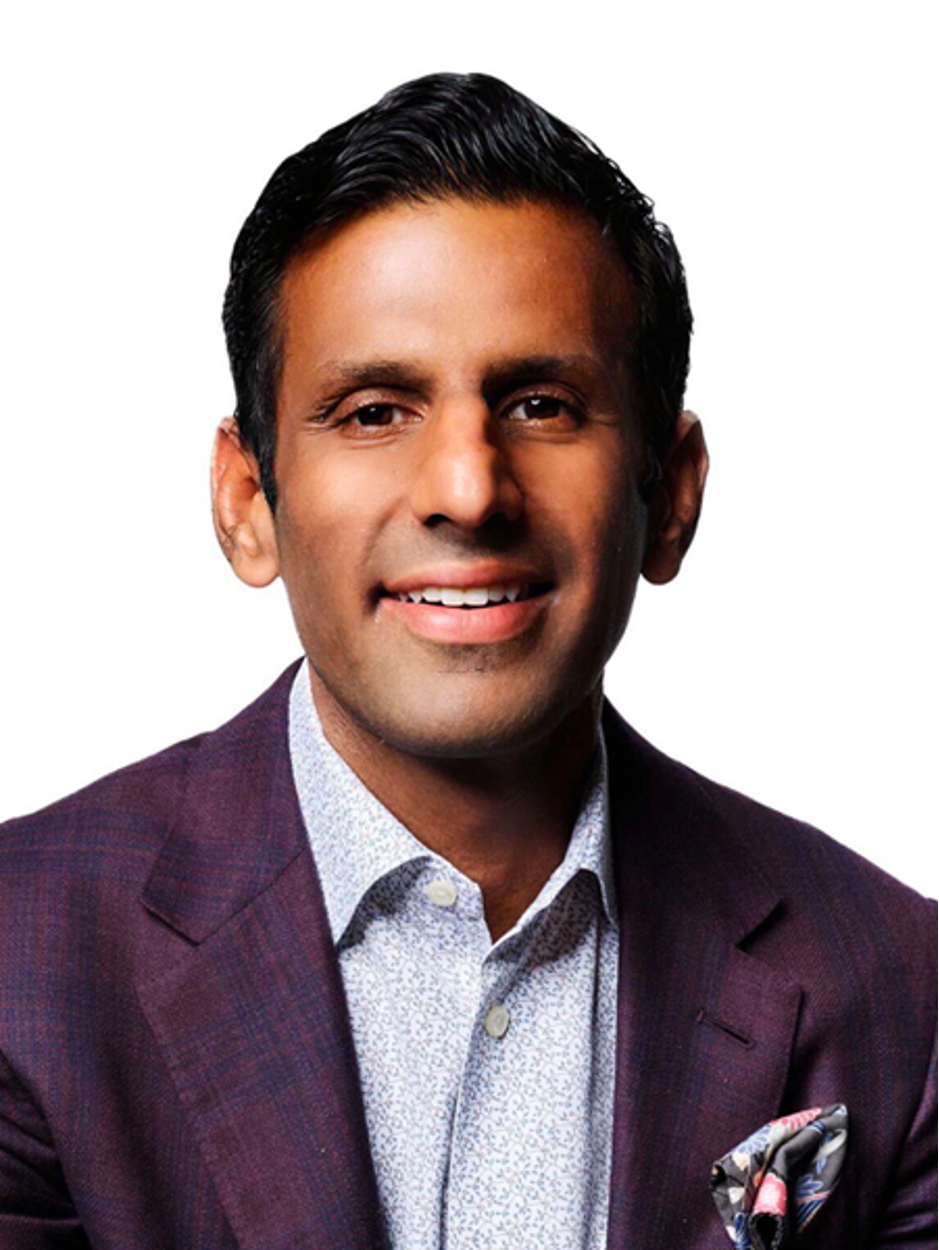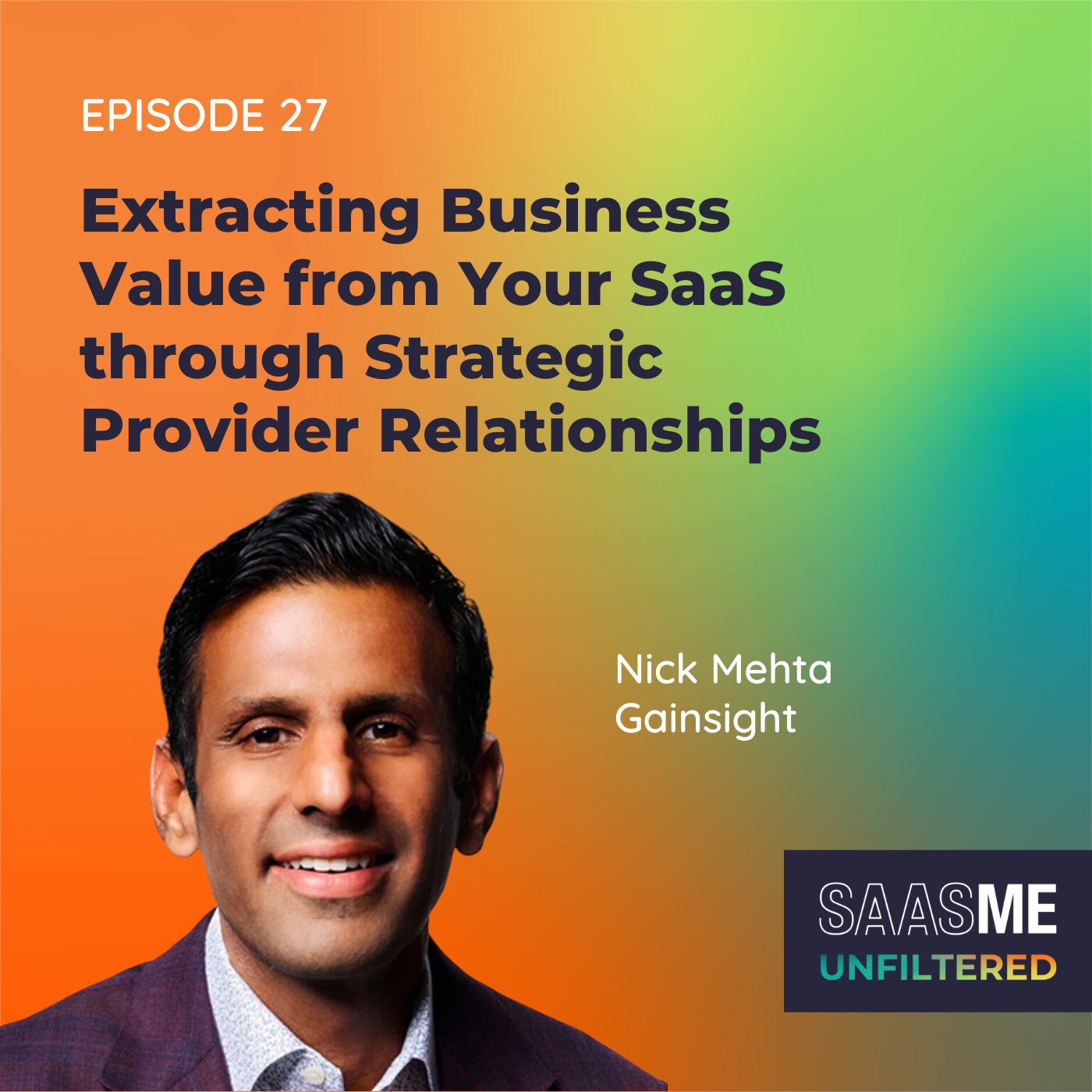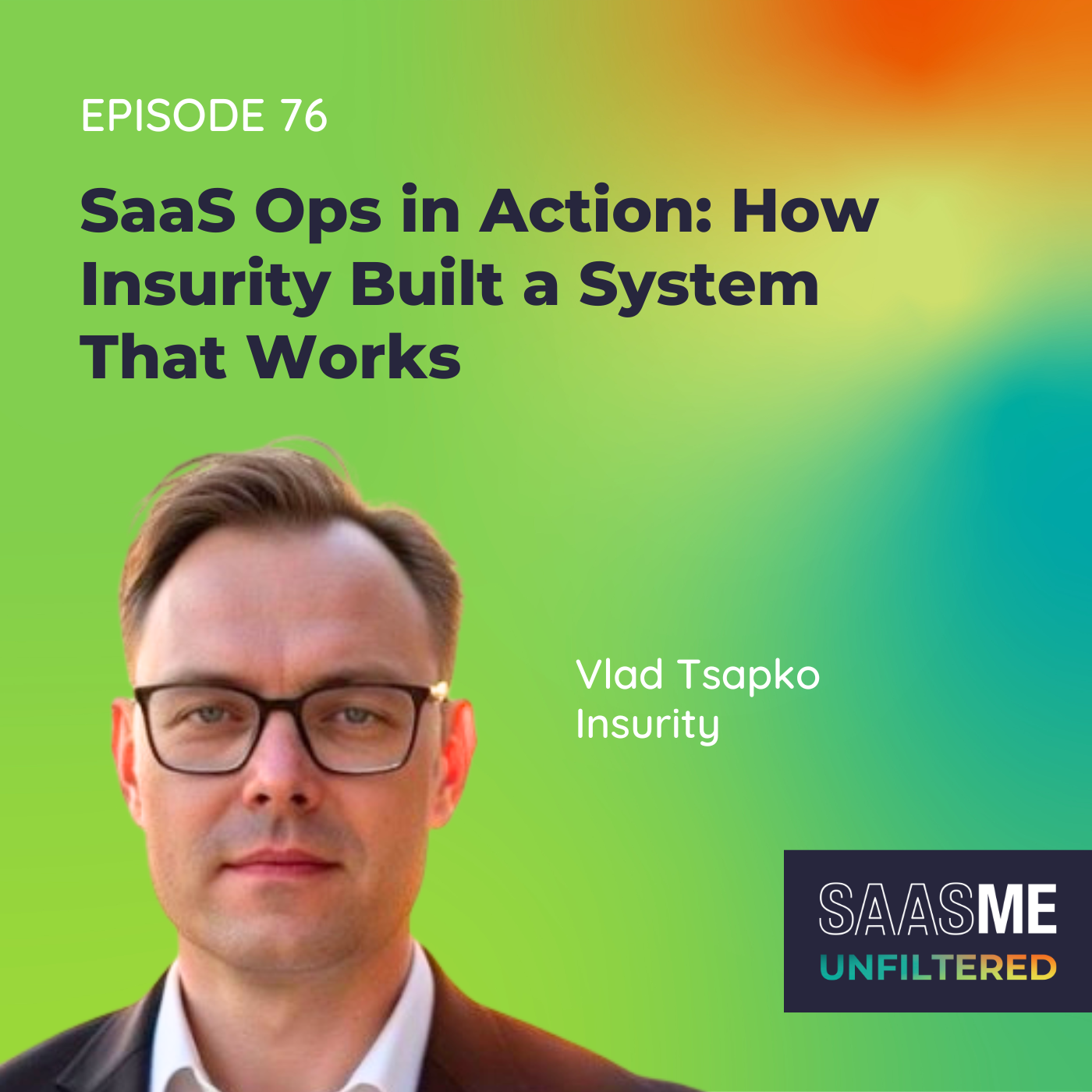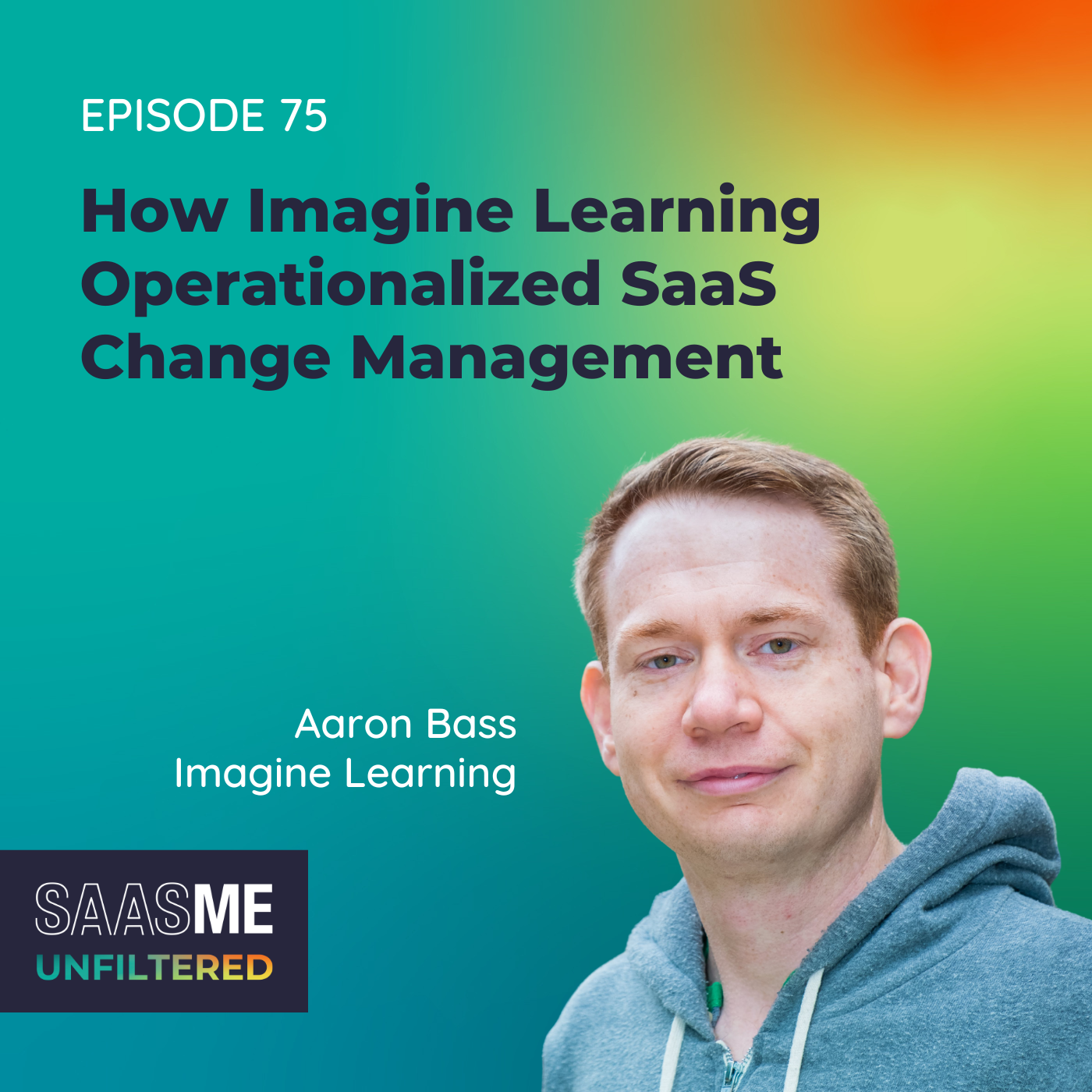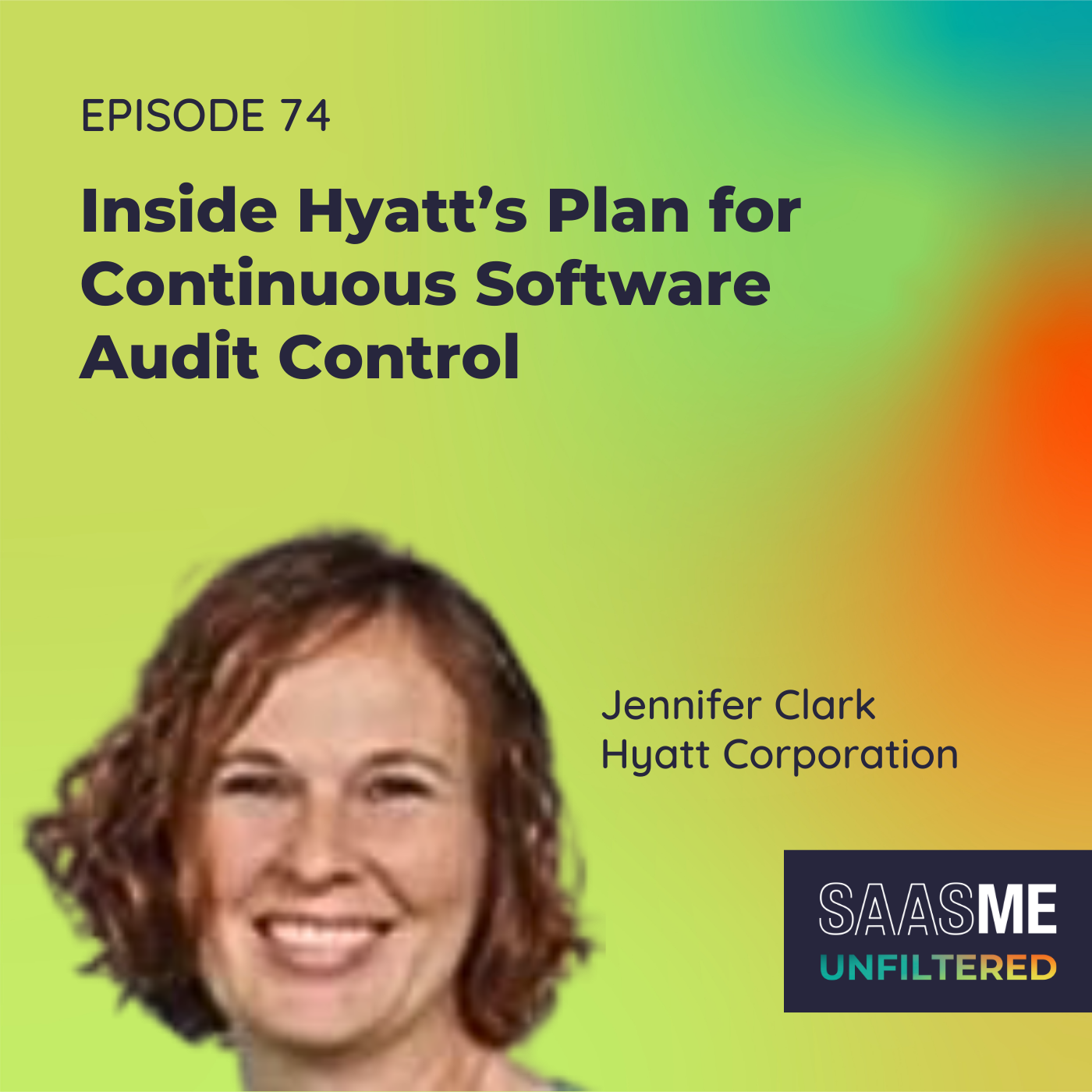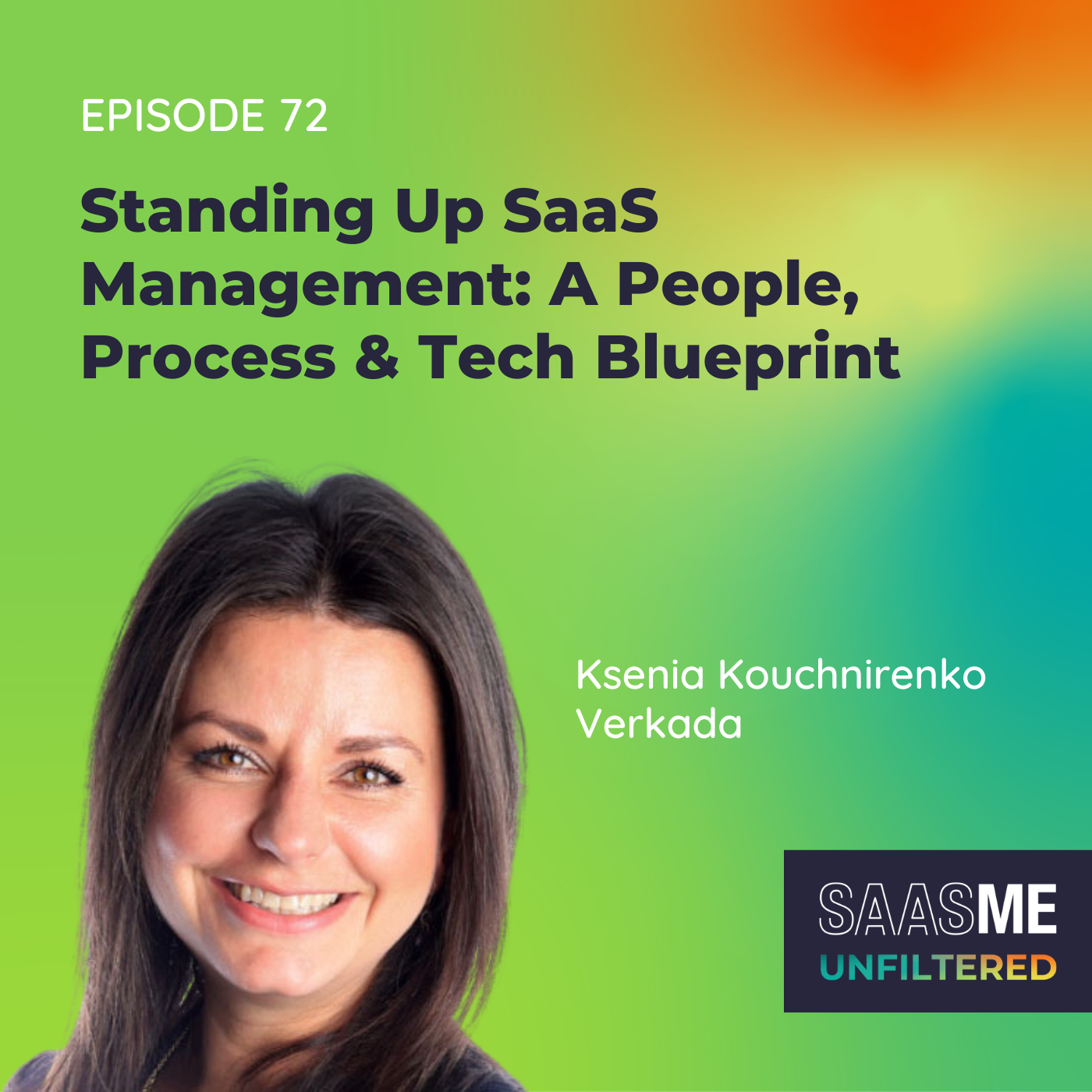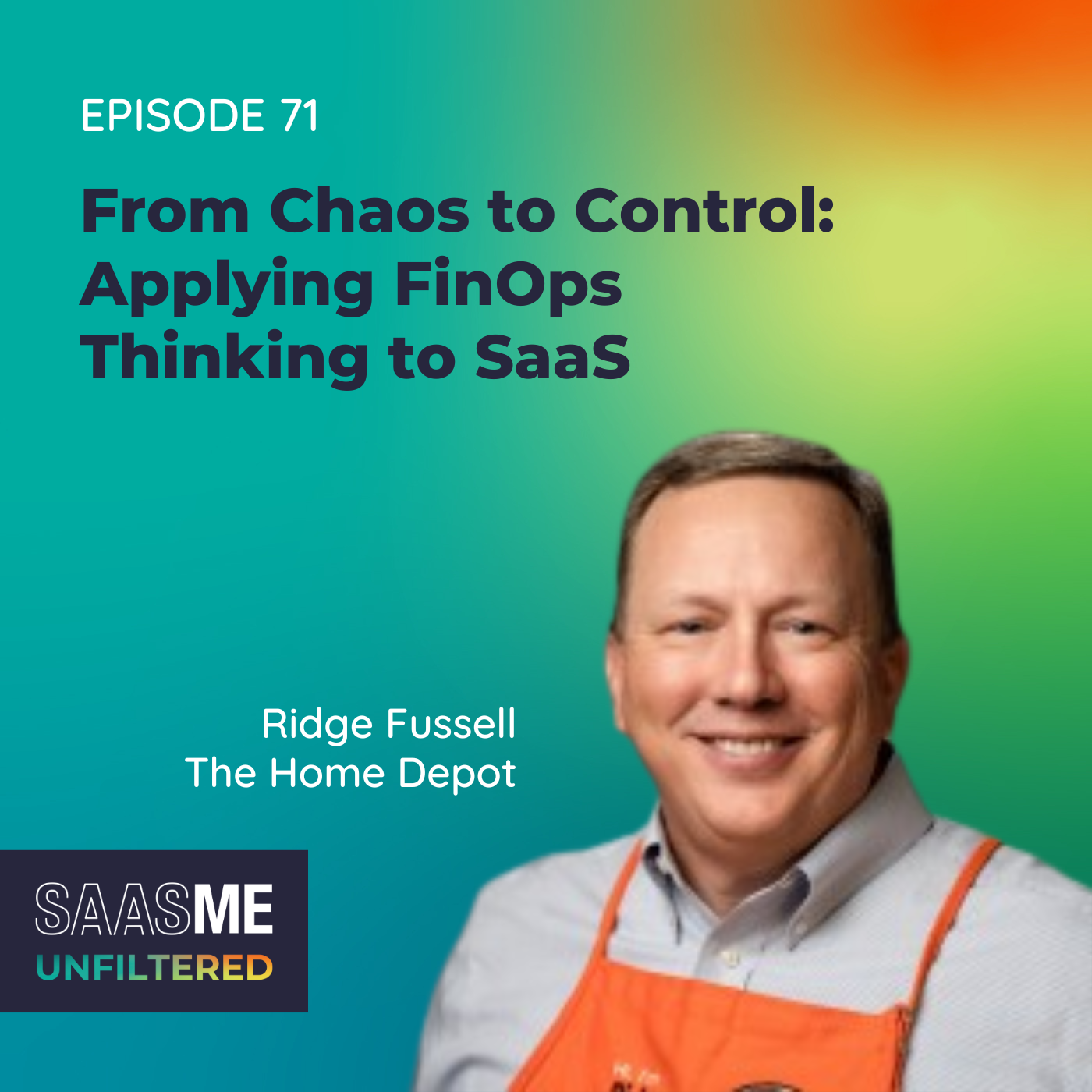Nick Mehta: Extracting Business Value from Your SaaS through Strategic Provider Relationships
- 0.5
- 1
- 1.25
- 1.5
- 1.75
- 2
Nick Mehta: Now after the fact, now you're working with the vendor, the vendor should be able to show what's the value they're getting? What value am I getting now? And help you design that. It's a little bit complicated because you don't always know, okay, how do we control what was because of this? Because of other things, right? Think about reducing churn. Your product might have gotten better during the same timeframe. Your pricing could have gone down, lots of other things could change. Help that customer think through that.
Cory Wheeler: Hello, hello and welcome to SaaSMe Unfiltered, the SaaS management podcast, the show with give it to you straight, real life advice from pros knee-deep in SaaS every single day. SaaS management superheroes just like you.
Cory Wheeler: We are back for another episode of SaaSMe Unfiltered. Incredibly excited to have everyone joining us today. I'm Cory Wheeler, co-founder and chief customer officer here at Zylo.
Meredith Albertson: I'm Meredith Albertson, chief marketing Officer at Zylo.
Cory Wheeler: Okay, so the guest this episode-
Meredith Albertson: Very excited.
Cory Wheeler: Very excited. I've been waiting for this for a while. This guest considers himself calls himself a wannabe Pittsburgh Steelers football player who plays a day job as a leader of a technology company as CEO of Gainsight, which by the way was named number one on Glassdoor's Best Places to Work in 2023. He works with a team of over 1400 human beings who together have helped create the customer success category that's already taken over the global SaaS business model. He has been named number two CEO by the software report in addition to earning the entrepreneur of the year for Northern California Award, he's co- authored two books on customer success called Customer Success and the Customer Success Economy. He's passionate about family, football, philosophy, physics, fashion, parody music videos, SaaS customer success, and most specifically, he's a massive Swifty. As Chief Customer Officer here at Zylo, I'm definitely a fanboy of our guest on the episode. It is none other than Nick Mehta. Nick, welcome to the SaaSMe Unfiltered podcast.
Nick Mehta: Really appreciate it Cory and Meredith, and thanks to the Zylo team for having me. This is going to be fun. Thank you.
Cory Wheeler: Let's get into it.
Meredith Albertson: Well, so SaaSMe Unfiltered is, it's a podcast that we've built for professionals that are knee deep in SaaS management every single day. Now, over the past two seasons, we've learned a lot from our customers and some incredible brands and luminaries in the space about how to really effectively execute SaaS management strategies. Now, today, we are very excited to flip the script and chat with Nick about the other side of the SaaS value equation from the provider perspective. Gainsight helps over a thousand customers deliver world- class customer success. How do we bring SaaS management pros together in a shared way with providers? That's what we want to find out today. We're going to focus on defining value, which I know you're very passionate about, Nick. We're going to focus on the shared goals that both Zylo customers and Gainsight customers have together. We're going to learn a little bit about, more about Nick and about Gainsight along the way. Very excited, super fun. Let's jump into it.
Nick Mehta: Sounds great.
Meredith Albertson: Even before the economy got rocky, we saw this from our customers. We were witnessing the great rationalization happened from all this software bloat that the pandemic had created. Now we're all in this economic downturn. There's a lot of uncertainty. Software solutions not only have to be cost effective, but also drive measurable ROI, the tech space especially, but really all businesses we're seeing this across the board and it's gone from this mindset of growth at all costs, everything we have to do to really how do we accomplish more with less. Now, Nick, tell our listeners, if you are not following Nick on LinkedIn, you must. His content is fantastic. Nick, I saw this in a recent post that you had about how critical it is to deliver value in ROI. Now that we're seeing a lot of CFOs are involved in deal cycles, how are you and your team helping your customers really define and measure value in ROI?
Nick Mehta: Yeah, totally. No, it's a hot topic and I think as you observe, I mean both of you, Meredith and Corey like and your whole company, I think people have realized with SaaS it's so easy to buy, so it's so easy to sign that DocuSign or whatever the electronic signature is. Because of that, companies bought a lot of stuff over the last few years. I think value has always been important, but right now value's kind of existential both for the buyer to make sure they're using their money wisely, and then obviously for the vendor because it's a huge part of their business as their existing recurring revenue. Value as a term has been thrown out a lot, lot and ROI has been thrown out a lot. I think it'd be interesting to talk about both. If you think about ROI, return on investment, we can talk about the return and the investment as the two different parts of it. The return is really the value and then the investments, obviously how much you're spending. I think there's some changes in how people think about both of those. In the return or the value, one of the things that I found is that buyers think about value in many different ways. It's easy for us as vendors to say, oh yeah, the value is about the dollar amount you're going to generate for them. First of all, I tell any vendor, every buyer's very skeptical of that dollar amount. You throw it out there we're going to generate a million dollars for you, whatever, super skeptical. Then there's obviously within those financial models, there's some things that maybe are more believable, maybe saving headcount and other things are less believable, like driving revenue. There's a financial value. I think that one of the things that's interesting is there's a lot of other types of value between a vendor and a buyer. There's the alignment to my strategic priorities. Lots of times software isn't on its own driving financial value. It's a tool that's part of a strategy that the buyer has to basically drive some change in their business. For example, the buyer might be launching a new business and the new business, let's say it's a cloud business, and they need a set of technologies to help enable that. Those technologies on their own aren't driving value, but they're kind of a lever to the strategy. The strategy is what's going to drive value. I think there's financial value, there's strategic value. Another value that we don't talk enough about is the professional value. We're selling to companies. We're also selling to human beings. For those human beings, the software helps them get recognition and promotion and maybe even the next job in some cases, that's obviously not necessarily what the company cares about, but the human beings care about that too. There's professional value, there's alignment between values. What are the values of the vendor, the values the customer, are those aligned together? There's a really good infographic, you can find it online, maybe we can link to it in the show notes that has, it's called a B2B elements of value, and they build a pyramid ... Consulting Group, and they show all these different types of value. That's one thing I always like to say is there's many kinds of value. Second thing is within a corporation, within a buyer, there might be different definitions of value depending on who you talk to. The person dealing with your software day to day, the value might be, help me do my job better. Then you go one step up and it might be help make my team more efficient. Then one step up, it might be like, actually I don't care about the efficiency. I care about the outcome that this is driving. That's another thing that happens is within a company, the definition of value can change depending on who you're talking to. Then the last point I'll make is the investment side. We started with the return or the value, and then you got the investment, how much are you paying? I think prior to this year, in this last 18 months since the downturn, companies were very focused on just the top of that equation. Meaning what value can we get? How can we move faster? How can we do more? Almost like I'll throw as much money as possible to do that, to move faster, to do more. Now you're seeing a massive change where companies are saying, how do I do what I need to do but at the minimum cost possible, and this is where you're seeing a lot of vendor consolidation, companies are saying, I work with this big company, Microsoft, Salesforce, whoever, how do I actually do more with them? It's even true for midsize companies, Gainsight, we have multiple products in our portfolio and we're seeing a lot of clients trying to do more with us. There's this issue of it's not just about me driving more value. How do I do it in the most cost effective and efficient way? Sometimes that means consolidating vendors together. So yeah, super hot topic, and I always tell people it's no longer good enough to just have an awesome product. If you're a vendor, that's great, that's like a starting point. If you're not driving and articulating the value and if it's not at a really effective cost of investment, your beautiful product's going to be replaced with something else.
Meredith Albertson: I couldn't agree with that more. Nick, I love what you said about the provider and the buyer needing to align on value. How do they do that? Is that on the buyer? Is that on the provider side? Who needs to be asking those questions and kind of driving it forward?
Nick Mehta: Well, it's kind of interesting. I thought a lot about this because I think that part of the vendor, the provider's job is to help the buyer understand the value of what they could be doing. The analogy I like to use is you think about trying to work out and get in shape and you work with a personal trainer, and if you're a super hardcore athlete and you work with a personal trainer, you might go to that personal trainer and be like, " Look, I want to do plyometrics on this day and I want to do heavy lifting on this day and I want to do whatever." Or you might be like most people and go to the personal trainer and be like, "What are your goals?" You're like, "I don't know, I just want to get in better shape." Then they're like, "Well, specifically here's a pattern of five different types of things we've seen. Some people want to get bigger, some people want to get more lean. Some people think about long-term health." Then the personal trainer kind of guides you through defining the value you're going to get from the personal training and then from those value, then if it's like, I'm going to get leaner, then they might say, "Well, to get lean, we're going to do a combination of HIIT exercises and Pilates or whatever." They're guiding you to that. They're not just asking you an open-ended question and expecting you to be the expert. I think the same thing is true with vendors. You understand the potential value your solution offers because you've worked with hopefully lots of companies. In Gainsight, we've worked with thousands of companies and customer success, and we built a value framework, and this is something I think every vendor needs to do. It was basically what are the six most common drivers of value for when people want to do customer success, which is ... Right? Things like reduced churn, drive more upsell, improve efficiency, et cetera, et cetera. We built this value framework, it's called O2, stands for operationalizing outcomes, and it goes from those high level value goals to then the next level, which is the business processes you want to implement to make those goals a reality. It's very similar in the personal training analogy to going from, I want to get lean to, okay, I'm going to do hit workouts, and then from hit workout, you might go to, " Okay, here's the specific things we're doing day to day." In our value framework, you go from, I want to reduce churn to, I want to implement a risk management process that helps me reduce churn to then, okay, I'm going to use these features in Gainsight to make that happen. And so I think every vendor, it's on them to become the expert in the potential value of their solution to build a framework for the buyer to help understand it and then give the buyer the tools to then figure out, okay, for you, what are you looking for right now? By the way, that's going to change. You know, might the personal trainer thing, you might start out and say, Hey, I want to get lean. Then like, "Actually, now I want to get really fast. Now I feel lean, I want to get faster. Now that I'm fast, I want to actually get better at jumping." I think this is a never ending process, but it's all about the vendor being the expert and being the trainer for the customer to guide them versus just expecting the customer to be the expert.
Cory Wheeler: Okay. What I heard there is value is varied. There's a lot of different ways to define value. There is a responsibility on the provider to be leading and shepherding the way to get to value. You've got to back that with data. You've got to have an entire process. You described a great framework, a waterfall that kind of starts at the top and comes all the way back down to data. How do you put data in the middle of that for your customers across many different definitions of value and many different definitions of value, as you said by persona?
Nick Mehta: Yeah, totally. Then I think what you can do is start saying, okay, I want to quantify that value you were just saying. Right? I think that there's two different kind of quantifications, there's a potential value, and then there's the realized value. Potential meaning before I start working with the vendor, how much potentially could I drive? Let's say that the client wants to reduce churn. Okay, great. Well everyone wants that. Right? Most people want it. A company like Gainsight, I could go to the client and get some basic statistics about customers and segmentation and then look at our benchmark data and say, the typical company of your size with these customers has reduced churn by X, let's put it a new model. It turns out there's a extra revenue of 10 million a year. Great, awesome. All of us know we've been around the block enough to know, hey, that's just a spreadsheet. It's only as good as the inputs you put in and out. Now you're working with the vendor. The vendor should be able to go show what's the value they're getting? What value am I getting now? And help you design that. It's a little bit complicated because you don't always know, okay, how do we control what was because of this, because of other things. Think about reducing churn. Your product might have gotten better during the same timeframe, your pricing could have gone down, lots of other things could change, but help that customer think through that. Give you a very tangible example there. When people buy our software, one of the things they often want to do is literally just make their team more scalable and make their team be able to manage more customers, get more efficient, et cetera, et cetera. We have a very rigorous process where we look at, okay, how many customers are being managed by person and how many hours are they spending per week on different activities pre- sale. Right? That's our level set. Then after the sale, after the deployment, we go back and we actually measure how things have gotten better. We actually have this stat now that the average customer of ours saves per person seven hours per week. At a 40 hour week approximately seven hours a week, you're getting back and then you can deploy that to take you on more accounts or doing a better job. I think then it's more believable because you've actually measured it on real world evidence versus I just took a spreadsheet and I put in a number and multiply times a million, and that's your output. That's not very believable. People call this value realization. It's not just about the value definition, it's about what value have I actually realized. More and more customer success is becoming about how do I help the client realize the value and honestly be able to show it to their boss so they can go back to their boss and be like, look, we're saving this much time using Gainsight or Zylo or whatever else. Right?
Cory Wheeler: Totally. What's that happy balance of delivering that via customer success and delivering that via your own product?
Nick Mehta: That's right. Yeah. I mean I think ideally you're doing both. One of the tricky things is some products by nature have captured all of the things that might be the value. For example, there's some products I think of someone like Coupa. Coupa makes procurement software. Actually people listening, probably some of them use Coupa and given what they do. Companies like that basically have a closed end view where they can see how much you've saved. Concur is another example. They do travel and expense software. Concur can see how much money you were spending on travel before, how much you're spending on travel now, how much you're saving. Concur actually as a Gainsight customer, they do these really cool automated reports on the product using or some technology to benchmark that customer's travel spend versus other companies and say, this is how much you're saving. There's other vendors where they're enabling a business process but they don't see the outcome directly. It's harder to do it in the product. They need to spend time with a customer building what we call a success plan, which is, okay, what are your big picture goals and how do we fit into that? Imagine you're Splunk. Splunk does log management software and you can use that for anything from making your systems more secure to improving your uptime. Splunk can't tell what the outcome of all that is. All they see is the log data coming in and out. Depending on where you sit in the stack, if you're kind of seeing the financial end- to- end process, you can probably build it into the product. If you're more like infrastructure or horizontal tool, you probably have to build a plan with the customer.
Meredith Albertson: If you are not unlocking the full value of your SaaS, what are you doing? There is no denying it. SaaS is mission critical to your company's growth and success. As the number two operating expense for most organizations, it's your biggest opportunity to save money and drive efficiency. The time is now to do something about it. Join me and your fellow IT, SAM, finance, and procurement leaders at SaaS Me. SaaS Me is the industry's only dedicated SaaS management event where you can sharpen your skills, hear from your peers, and learn how to unlock value and responsible business growth through smarter SAS management. Register today at saasme. com. That's S-A- A- S- M- E- dot- com.
Cory Wheeler: Now changing this over a little, I'd love your perspective as the CEO of Gainsight as we talk about this rise of responsible business growth. What kind of internal changes have you made that follow along with the rest of the market? How are you looking, evaluating new purchases, renewals, and is there a change or have you leveraged your historical methodology in that process to buy and renew already?
Nick Mehta: We have, I think, adopted probably a lot of what everyone else has, which is just a lot more scrutiny on new purchases for sure. I think there's a set of questions everyone asks now, why do we need this? Why can't we do it in this other system that we already have? Are we really ready to implement this? Who's going to manage it? Is our data ready? When would we go live? What's the total cost of ownership? I think we're better at asking those questions. I think early days of SaaS it was more like, oh, this is great. This is Amazon, you just buy it and you're done. Right? That which is obviously not true at all, right? But we have that misnomer about SASS early on. I think people have gotten better at buying, which is the good news is I think the things that are being purchased now are much more considered than the things that were purchased over the last couple years as an industry, we all have a lot of indigestion for the two years of the feast software. We're going to get through that and we'll like keep what we're going to keep. We're going to get rid of what we're going to get rid of. Then I think we'll be back to a more normalized pace. Specifically what does that mean? In our world, hey, do we need four different ways to do collaborative work management? By the way, what ends up happening is you go into a company and group A is like, " I really need solution X." Group B is like, " I need solution Y." Then sometimes you have to be like, in other words, maybe solution X is 10% better than solution Y for a certain use case, but if we can save a lot more money than that, it might not be worth it. I kind of think that's why let's say Microsoft Teams as an example is having a lot of success because I think a lot of the things that Microsoft Teams does are done by other vendors that probably are better at what they do, but are they better commensurate with the spending? That's forcing the vendors that are competing with teams to be even better and raise their game. I think that's what we're trying to look at, even for our own spending, which is we have all these tools. I know each person needs their own tool, but are they really that different and that much better? Then as you know, the other value you lose beyond financial value is you lose the integration value because everyone's on different stacks and tools and things like that. I think we've gone through it. I think for our CIO, it's a constant process and our finance team because they start and they start consolidating and they bring it down to let's say 300 down to 200, and then all of a sudden it's back to 250. If you're listening and that's your experience, I'm sure that's like everyone. Then you try to bring it back to 200, now it's back to 275 again. It's a never ending thing, but it's important before people weren't controlling it at all.
Cory Wheeler: Totally. This is what our customers are going through right now and it represents a cultural shift. Do you have any, as a leader of Gainsight, how did you roll out or how are you still rolling out that cultural shift of, and not to say the Gainsight was in this camp, but growth at all costs to responsible business growth, these are changes that didn't come around before. The CFO and the CIO are now part of that decision making process. How do you change that culture?
Nick Mehta: Yeah, totally. I think part of it is messaging to people on why the world is changing a lot because I think it's been a absolute 180 degree turn for the average employee, especially if you're working at a technology company especially, but even more generally where it's growth at all costs and essentially everyone makes their own decisions, a lot of autonomy, which is great. Now you're like, " Wait, we actually need to run a business. We need to be profitable, we need to be responsible, we need more checks and balances." It can feel kind of bureaucratic to the average employee. I think though that when you try to give them a little bit of perspective, this is actually how the real world actually works. It's funny because I think a lot of the non- tech companies that might be listening have operated more like this the whole time. They had a little bit of a uptick in spending, but they were subject to the laws of physics on profit and things like that. The tech world was in this sort of suspended reality for a while. Explaining to employees, I do an email every Sunday night to the employees and I talk about the economy pretty much every week and I'm like, Hey look, this is an uncertainty period. The thing I tell people is it's not like this is some temporary thing. What was temporary? The was the last 10, 15 years. This is reality go using matrix analogy. You can either take the red pill and accept the reality or you can live in the matrix. Obviously, you can't do that. You just got to take the red pill. Help your employees understand what's changing and then obviously help them understand the P& L, meaning the income statement. What are the parts of our business that need to get better? That's when you start doing benchmarking. What do we spend on GNA as a percentage revenue, sales, marketing, R& D? Then you click into the next level, what do we spend on tools? How many tools per person? I'm sure you guys have tons of data on this. Then you start doing that analysis, you share with people, look, this is why we need to get better. The reality is the economy's tough. I think people understand it, they see the signals outside. Unfortunately a lot of people have gotten laid off and things like that. This is just part of a much bigger puzzle. You feel a little less bad losing your license to some piece of software when you see other people unfortunately struggling and losing their jobs. I think people, it's a little easier now, obviously not happy about the pain that creates for people, but it's easier now to explain to employees that the world has changed a lot and this is really the go forward. I think that's an important thing to lead people with is this is not some temporary thing, this is how we're going to operate kind of forever. It's hard and it's a big adjustment, but this is an adjustment you're going to need to make. We're going to have processes, we're going to have approvals, we're going to have rationalization of spending. It's going to happen all the time every year. You have to get used to it.
Meredith Albertson: Love hearing about your perspective internally as well and how you guys are looking at that at Gainsight. We talked a lot about value, responsible business growth and some of the frameworks I think are fascinating. If I'm on the provider side and I want to do one thing tomorrow and I want to work better with my customers on sustainability, responsible business growth, and I want to be more of that strategic partner rather than the tactical provider, what's one thing I could do tomorrow morning getting up to do a better job for my customers?
Nick Mehta: I think the one thing that when you ask people, somebody working with a customer, let's say they're a CSM or a salesperson. Right? CSM stands for customer success manager for people that don't know. You ask those people, " Hey, what's the definition of value to your customer?" Obviously we all get to see that. I'm sure Corey, you get to see that when you go to meet a customer and your team maybe prepares you and says, " What's the definition of value? What are their outcomes?" I have to see the same thing. I think sometimes you get to see the gap that we need to help our teams close. So every now and then I'll get a team member who says, okay, what's their client's outcomes and goals? They'll be like, " They want to use the new release of X, Y and Z." And I'm like, that's definitely something they want, but that's part of something bigger. I guarantee the CEO's not thinking about using the new release of X, Y, and Z from Gainsight. There's something bigger. And so the visual I actually like to use myself, which it's a little bit dated because not everyone's in the office anymore, but conceptually I think you're following me. In the old days had a whiteboard in their office and on the whiteboard, you'd write down your priorities, what are you trying to get done? The thing I always think of is what's on the client's whiteboard, not on your website. When you're the vendor on your website, you got a list of best products and solutions and marketing stuff and all that. What's on the client's whiteboard? On the client's whiteboard might be something successfully launch our new product line or expand to Asia or reduce our cost of goods sold or whatever. There's something on there. What that whiteboard figuratively, what it is is what's on their priority list. I think one of the things that's nice is you have to ask the question right the right way when you're talking to the client. If you ask your stakeholder who might be a little lower level person of the customer, " What's your goal?" They might tell you something very tact. They might be like, " We just want to roll out the new release." I ask it a different way, which is, " Hey, have you guys had an all hands with your CEO lately?" " Yeah." " Okay. What were the top priorities your CEO talked about? What were the things that they were talking about?" Then you want to build that ladder from, okay, how does what you're doing fit into that? Now another hack to do this if you're a CSM or salesperson, if it's a public company, find their latest investor presentation, just Google name investor presentation, and it's all there. They list it all. so I think you've really got to get to that mindset where you start with their goals at the company level and then work backwards to what your technology does versus what our natural instinct is. Oh, start with our technology and then figure out how to fit into the client.
Cory Wheeler: Love it. I want to transition that into a little bit of a customer success focus here around renewals, kind of a passionate area of mine, but you posted all of your customers are at risk. It's the brutal reality in SaaS, especially in this economy. As we mentioned at the outset, Zylo is helping our customers define value in whatever way they can. Gainsight is helping your customers define value and articulate that back to the business objectives and outcomes. It's all a part of data, but how do you challenge your customers? On our side, it is shocking how little, and because these applications are decentralized throughout the entire organization, you have different people that are analyzing the value that you may not even know about. The old reliance on just adoption has gone by the wayside. So how do you challenge your customers and also deliver that again site to really track and deliver on those outcomes. Then how do you map that to value? What is that framework that you're using?
Nick Mehta: Yeah, so the way we think about it is there's almost like a staircase of value that if you wanted a very simple way to think about it, and I'm just going to talk about a generic software product and we can talk about specific examples later. We actually have this acronym which is like DEARS, so DEARS. Starting out, if a customer bought software they never deployed, they're probably not going to renew it in this environment. So the first thing is deployment. Out of all the licenses, how many have been deployed? I'm sure I know Zylo can track that, right? It's great. That's the starting point. As you said, that's not the end all, be all. Then the E stands for engagement because I think it's a sign of how strategic you are. How often are you meeting with that strategic sponsor to your client? If they're not meeting with you, it's not because they're a bad person, it's because what you're saying isn't resonating with them. It's just not their priority right now. It's a sign if you're a vendor, you got to go try a different message or try a different stakeholder or whatever. Then we go to adoption, which as you were talking about, you can do your percentage of users that are active. I'm sure, again, you guys can help people analyze that. And I think like you said, that's necessary but not sufficient in this environment. The reason it's still matters is even happy, successful customers are looking to drop licenses if they're not using them. As a vendor, you will have some churn that a happy customer's like, " I just don't need those extra 10%." Especially because people have done layoffs and they're not hiring as much it's a real risk factor. You go deployment, engagement, adoption, then you get to ROI, which is we were talking about what's the articulated business value that you could actually get in writing ideally from your stakeholder that you can use with procurement, they see the value they've had. It doesn't have to be purely financial. It could be anecdotes too. We saved this customer because of the software we were able to do X. It's a little bit of storytelling too. Then I get the final S, so DEARS, the S is what we call stickiness, which is the idea that in addition to tangible value, are you embedded in a business process that's really important for them where frankly it would be a pain and a lot of work for them to switch and they wouldn't want to necessarily want to in this environment. The best vendors right now are able to have good deployment, great engagement, adoption, ROI, but also are in a fundamentally sticky position in the stack right now from a buyer perspective, you don't necessarily want to be too sticky to a vendor, so you probably want to maintain some optionality, but at the same time you're not trying to deal with too many vendors. For mission critical things, you'd love to have somebody who can really just take care of it and do it well. I think what I love about this podcast is there's a lot of benefit in the long term of transparency between the vendor view of the world, which is kind of my world and the buyer view of the world, which is your world. Then how do we bring those together so we just agree this is how we're looking at value, this is what we're trying to achieve, let's share the data, let's help you make a good decision, love what you guys are doing because of that.
Cory Wheeler: That's the end all, be all. That is making the right decisions, bringing all of the data together far beyond just historical login data and really truly understanding engagement, value delivery, all of the above in a single platform for everybody to benefit from. You're preaching to the choir.
Nick Mehta: Love it.
Meredith Albertson: A little bit on the topic of renewals, but I think it's the opposite side is really churn and talking about churn and down economy and you have so many great frameworks and this way that you view things. I recently, again, I promise I'm not stalking you on LinkedIn, you have a lot of great content. You recently did an interview and it was talking about the framework and this approach that you have for talking about churn, facing churn for SaaS companies today in this down economy. Can you share a little bit more of that framework with us? I think it was talking about gravity naturally pulls towards churn was one of the first points.
Nick Mehta: Yeah, totally. I think this idea that in this world and where people, they buy software and so a buyer, somebody listening to this podcast maybe works with one of your business stakeholders and you're like, " Hey, we need to buy a solution for something." Great, you bring that in and you buy it for the needs that we have today in a company. Then there's a stakeholder there and you're all planning the rollout and you start using it. It's awesome. Life's good, this is the beginning of the story, but then things get complicated. The stakeholder leaves the company. The person that bought it leaves, maybe the procurement person leaves and then the company's goals change because they do. That's how our companies work. The thing they we're working on is no longer relevant. There's something else that's really important. There's more financial pressure than ever. And so the reason that I think of churn gravity is it's one of those things where literally if you ignore it will happen. It will absolutely happen. If you forget about gravity and you're walking down a cliff, we all know it will happen. The same way, if you don't realize the natural tendency is toward churn, it will just happened to you. Not necessarily overnight, but absolutely over time. I've talked to a lot of vendors who are like, oh yeah, we have really high renewal rate and everything's great. I'm like, great. Awesome. Make sure you keep it that way. Because if not, the forces will... What are the forces specifically? Well, as I mentioned, one force is stakeholder change. Another force is goal change within the customer. Third force is competition, right? It's a free market. If you're delivering great value and you're getting a lot of financial value for that, some other entrepreneurs out there somewhere in a big company, small company be like, I'm going to do that too. Then they come in, they do it for half the price or whatever. One of the best quotes ever in business history in my opinion is it's from Jeff Bezos at Amazon where he said, " Your margin is my opportunity." He'd always say, " Hey, anytime I find some business line that has high margins, I'm like, let me go do that." That's kind of what he did with Amazon Web services obviously and famously. This idea that you cannot let it be stagnant, and so you constantly have to work at it. That's why I think there's this famous myth, some of you guys probably know the myth of Sisyphus, which is the person that gets condemned to push the rock uphill forever, until eternity. It can sometimes feel like that because as a vendor, there's never a done. You're never done. You're always going to keep going. There's always going to be new goals and you're going to be new stakeholders and there's going to be new competitors and you either love it because you love that the grind or you don't like it and probably want to do something different.
Meredith Albertson: Well, Nick, your passion for value for that partnership between the provider and the customer, it's contagious. I'm enjoying this conversation so much, but I want to ask you, what is a commonly held belief that you actually passionately disagree with when it comes to driving value?
Nick Mehta: Yeah, great question. I'll give you one that immediately came to mind, which is driving value is not antithetical to selling. There's a lot of belief out there historically that sales is transactional and customer success about driving value. Obviously, I'm a big believer in customer success teams. I think they're super important, but I think that customer success is a company- wide process. It starts with the way you market, you build your product actually, and then the way you market and then the salespeople and then implementation, and then the customer success team, all of them need to be about value, including sales. The best salespeople I know do everything we talked about naturally. They understand the buyer's deep goals. They actually want to drive those goals. They get a lot of reward from not just closing the deal, but actually later on the buyer's saying, look at the amount of money you saved me or the got me promoted my job. That's part of why they do the job. I think this idea that sales and revenue is not antithetical to the client getting value. These are one and the same thing. We need to build business processes and organizations where we're all about value and it's going to drive revenue for us. It can't be charity, right? It can't just be value for the client and it can't be transactional like it may be in the old world. You just have to find a way to do both. Yeah,
Cory Wheeler: Totally agree with that as well. Another kind of higher level question, that was fantastic. How over the course of time have you really evolved the approach to driving value with customers at Gainsight? So what huge learnings did you have or what failures have always stuck with you that you've said, " Boy, I give this advice out, we'd never do that again." What are some of those highlights?
Nick Mehta: A few things that have jumped out to me. So one we talked about was building this framework of value so that you're not asking the client what the value is, you're actually guiding them to it. Second one is not assuming that value always starts with your product features. In the early days we would be like, Hey, how many times they click on this button? Let's figure out how that correlates to value. Actually that's just not realistic because that's not how the way the client thinks about value. As I said, the client starts with their financial metrics or their business goals and then turns into business processes and then turns into clicking on a button at Gainsight or maybe a couple layers deep. Third one that I think is maybe more recent is the idea that we as vendors need to be brave and be prescriptive. We need to show the client the best way to get to this value. Again, using the personal trainer analogy, the personal trainer is telling you all kinds of things you're doing wrong. I had my session yesterday and she's like, " Yeah, your back's too arched. Your core's not tight enough and you need to keep your arms in your body." I'm paying her to do that. I'm happy she does that. We need vendors and CSMs and salespeople to step up and show the client the best way to get the value and not be afraid of it because the client's hiring you for that. Right? They're hiring you to get the best way to get to this path to value. That may mean the best way to deploy the product or to use it or to roll it out and to be prescriptive about that versus waiting for the client to say, " Oh, how should I do this?" It's the most annoying thing in the world when the client's like, " Hey, what do you recommend?" The vendor's like, " I don't know. What do you want to do?" Right? This is exactly what Gainsight, every young company is. In the early days we didn't know what we should do. The client would say, " Well, how should we roll out Gainsight?" I'd be like, " I don't know. How do you want to roll out Gainsight?" But if I went to my personal trainer and I was like, " What are the best ways for me to get in shape?" And she's like, " I don't know. How do you want to get in shape?" I'd be like, " Why did I hire you? Why exactly did I hire you?" This is why I think there's a big opportunity for us to all be brave and realize it's our role as vendors to get our clients to their outcomes and goals and sometimes to push them along the way.
Cory Wheeler: Oh boy, all of that resonated early in our days. We would come with all of this data and we'd say, what's most important to you? What do you want to go after? And we've rolled now out since our Zylo value framework. It's the ZVF internally, but it's the prescriptive approach because really our customers are more than likely doing this for the first time. They're more than likely trying to learn, I was a practitioner in their seat. Having a vendor that comes to you or having a partner that truly comes to you and shows you the way and says, no, this is what you want to be doing. You don't have to, but these are the best practices and this is how you're going to get to that business outcome, which is the reason that you signed up for us in the first place, it truly resonates. I think your focus on the prescriptive methodology and a value framework is the most spot on thing that I've heard in a while, and I love when you're talking about it on socials.
Nick Mehta: That's great, man. Thanks.
Cory Wheeler: It's great. Okay, so we're going to close this out. This has been just a blast to listen and learn from you. We're going to close this out with our rapid fire section. Just a few different questions. We'll throw out a scenario. You can give us one word or a quick response back, but really designed to just get your initial thought on each of these questions. Are you ready?
Nick Mehta: Sounds great. Let's go.
Cory Wheeler: Okay. My setup is that building a company, building a company truly from the ground up is different obviously than operating a large enterprise. The question is remote or in person?
Nick Mehta: Both work.
Cory Wheeler: Both work.
Meredith Albertson: All right. I couldn't pass out the opportunity to ask you this question. Favorite Taylor Swift song?
Nick Mehta: That's the hardest question you could possibly ask, but the answer is All Too Well, 10 minute version. Her canon, that's her ultimate breakup song. All Too Well, 10 minute version.
Meredith Albertson: Love it. Great choice.
Cory Wheeler: Good answer. This may be the second hardest question then ever. Favorite Steelers player of all time, not named Franco Harris.
Nick Mehta: Troy Palomalo, for sure. The hair. How do you beat the hair?
Cory Wheeler: No doubt. Ugh, just a nightmare in the backfield. Great answer.
Nick Mehta: Exactly.
Meredith Albertson: Actually, this might be the hardest rapid fire question. What do you love most about Gainsight?
Nick Mehta: That is a hard one. I would say I love the fact that it feels like our customers and our community and our employees are all kind of one thing, like very integrated together.
Meredith Albertson: Love it.
Cory Wheeler: Perfect. This has been an absolute joy. It's a bucket list item for me as a chief customer officer here having you on the show, sharing your wisdom for our listeners. I think it all resonates. It's all about defining value, learning from your vendors, creating strategic relationships, hitting those business outcomes. Boy, you covered the gamut. Thank you so much for being on the show.
Meredith Albertson: Thank you, Nick.
Nick Mehta: Oh my gosh. Been awesome. Meredith, Corey, thank you so much. Really appreciate it.
Cory Wheeler: Did you enjoy the episode? Pass it along to your friends, subscribe to get notifications for the latest episodes. Share your favorite takeaways, and join the conversation on social media using# saasmeunfiltered.
DESCRIPTION
What value are you truly getting out of your SaaS applications? Nick Mehta, CEO at Gainsight, knows all too well how important it is to drive business value from your software. In fact, he and his team have developed a customer success approach that’s taken over the global SaaS business model. In this episode, Nick shares how to create more strategic relationships with your SaaS providers and realize significant value for your organization.
Key Takeaways:
- [00:00 - 03:25] Introduction to Nick Mehta
- [03:29 - 08:41] Defining and measuring value in ROI
- [08:43 - 11:34] The provider and buyer aligning on value
- [11:38 - 14:26] The definition of value depends on the data
- [14:28 - 16:03] A happy balance delivering customer success and product value
- [16:57 - 19:42] How has Gainsight looked at responsible business growth in the current market?
- [19:42 - 22:43] Changing the culture around who is involved in business-growth decisions and processes
- [22:47 - 25:31] How to be a strategic partner rather than a tactical provider
- [25:31 - 29:36] Thinking customer success in the current economy, and how to map value to increase renewals
- [29:36 - 32:36] Churn and creating frameworks, gravity naturally pulls toward churn
- [32:36 - 34:06] Driving value isn't antithetical to selling
- [34:07 - 36:26] Driving value with customers at Gainsight, learnings and failings
- [36:27 - 37:16] The Zylo Value Framework, ZVF
- [37:23 - 39:09] Rapid fire, Taylor's Version
Today's Host

Ben Pippenger
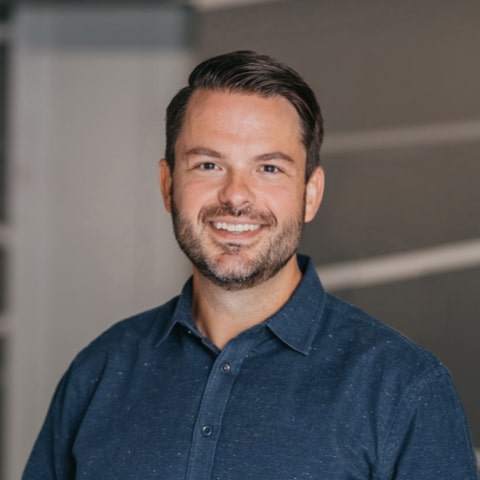
Cory Wheeler

Meredith Albertson
Today's Guests
